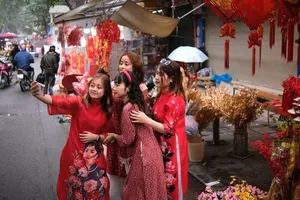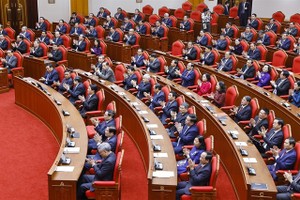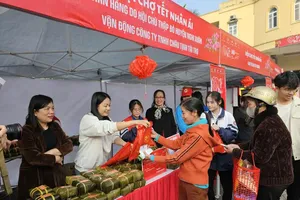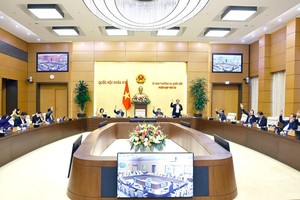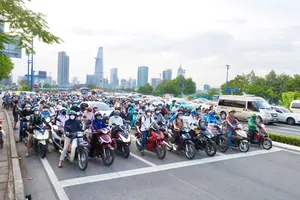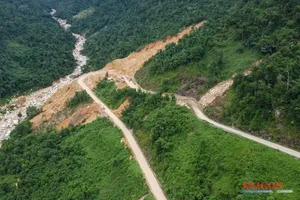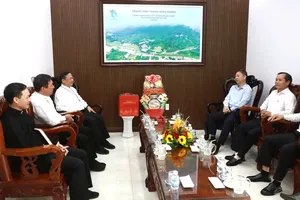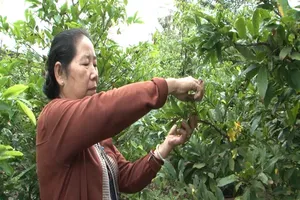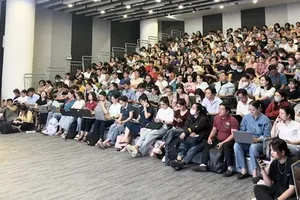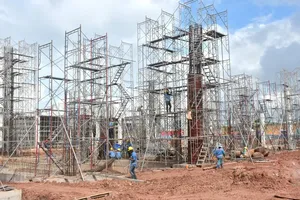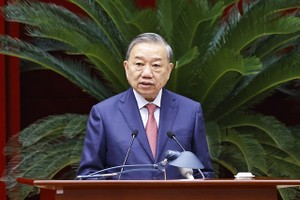
On this occasion, Sai Gon Giai Phong newspaper reporters visited many historic sites to seek marks, meet witnesses in the northern border defense fight and record changes and development in the sacred land of the country after the fierce battle in 1979.
Early on February 17, 1979, the Chinese troops opened a mass attack in the entire northern border line from Lai Chau to Quang Ninh province.
In Quang Ninh, they used many heavy weapons to fire Vietnamese side positions including Border Post 209 or Po Hen Border Post in Hai Son commune of Mong Cai city, groups of workers in Hai Son plantation and many residential areas alongside the border line.
Despite of fierce firepower, nearly 60 soldiers of Po Hen Border Post together with local residents resiliently fought to the last bullet with the iron determination of protecting the post, the country’s frontier and land.
The memorial site of Po Hen martyrs looked like a big construction site at the end of January 2019 when Po Hen soldiers and workers were making efforts to repair the site and inaugurate it on the occasion of the 40th anniversary of the northern border defense fight and the 60th anniversary of the Traditional Day of Border Guards.
Burning incense to commemorate two comrades who fell down 40 years back, 67 years old Hoang Nhu Ly, scout of Po Hen Border Post, could not hold back tears recalling the violent battle in the morning on February 17, 1979 to protect the post.
Mr. Ly took SGGP reporters to the back side of the monument. After crossing a swift running spring and some slippery slopes in the chilly cold, they arrived at a stone stele in the forest. The stele was carved with the names of Lieutenant Pham Xuan Tao and two other martyrs.
Forty years back, the stele was the place where the Lieutenant together with many soldiers of the post sold their lives dearly in the battle against the Chinese attackers in the morning on February 17.
Lieutenant Pham Xuan Tao from Thai Binh province was the commander of a border post in the southern province of Tay Ninh before being mobilized to Po Hen Border Post in front of unusual fluctuations in the northern frontier situation.
After 1975 when the country was reunified, he served at the steering board of the Armed Police Force in Quang Ninh province, which is Quang Ninh province Border Guards now. Early 1979, he was assigned to command Po Hen Border Post on February 15.
Right after receiving the new mission, Lieutenant Tao together with deputy head of the border post and Mr. Ly immediately inspected high spots in the border post and fortification system to prepare for fighting.
In the afternoon on February 16, Lieutenant Tao and some commanders in the post had a warm talk with the confidence of being willing to cope with the enemy’s tactics. He was experienced in clashing with the enemy from the other side of the border.
Knowing that the enemy would attack, they did not surprise that the assault took place as early as it did. Chinese troops fired to invade Vietnam along the entire northern border line just a couple of hours after the talk. They used heavy artillery to fiercely fire Border Posts 209 (Po Hen), 210, 211 and 212, forestry workers groups and residential areas in the border area from Quang Ninh to Hai Hoa, Mong Cai to Thanh Phun and Po Hen.
Thirty minutes after the unexpected raid, the enemy sent a force comprising one regiment and five battalions divided into three directions to attack Po Hen Border Post.
Despite of fierce firepower and crowded enemy troops, soldiers at the post did not flinch and resolutely fought to keep the post and the border land.
Recalling that moment, Mr. Ly said that standing in the post and looking around, he saw the enemy troops everywhere. At that time, Lieutenant Tao was injured but he still loudly shouted “Protect the post” and ordered a reconnaissance squad to move behind the post in Que Hill to assist their comrades to take back the spot.
Receiving the order, Mr. Ly, commissar Pham Xuan Tao, deputy head of the post Do Si Hoa and other soldiers just fought to keep the post without minding their lives. Mr. Do Si Hoa and Pham Xuan Tao did not leave the battlefield until they laid down.
Mr. Ly said that he was fainted. When gaining consciousness with injures at noon on the same day, he saw enemies around him and fell into their hands. Many officials and soldiers of the post had died. The Chinese side returned him through the border gate in Lang Son province on June 22, 1979.
According to history pages about Po Hen, at 4:43a.m. on February 17, 1979, the enemy used types of firepower comprising mortars to unceasingly assault the post battlefield. Thirty minutes later, about 2,000 Chinese troops overflowed while the post’s soldier number was only 50. A majority of them laid down after bravely struggling and hurting many enemies.
In the area of the old Po Hen Post, a monument has been built with two large steles carved with names of 86 martyrs comprising 45 soldiers from Po Hen Post, workers at Hai Son Plantation and commercial staff at Po Hen group who had given up their lives in the morning on February 17, 1979.
Among the laid down ones were 32 year old sergeant Do Si Hoa, 43 year old Lieutenant Pham Xuan Tao and 25 year old Hoang Thi Hong Chiem, who is the only woman falling down in the battle. Hong Chiem should have withdrawn after collecting her commercial store, still she stayed to fight against the enemy with her boyfriend who was 26 year old Bui Van Luong. The man also laid down in Po Hen land.
Forty years after the fight for the country’s norther border territory, Po Hen Border Post has been rebuilt about one kilometer from Po Hen monument. Peaceful life has returned in the war-torn land and Po Hen hamlet has become a new style rural area in Hai Son commune.
Closing the past, Po Hen-Tan San open path has been opened linking up Po Hen border market in Mong Cai district of Vietnam’s Quang Ninh province up to Tan San border market in China’s Fangcheng, contributing in boosting socioeconomic development and border trade between the two countries.
